Eduardo Levy Yeyati, Maria Soledad Martinez Peria, and Sergio Schmukler
Much of the discussion surrounding the Greek crisis revolves around the probability and implications of a sovereign default and on whether the introduction of a national currency (which, for simplicity, we could call the new drachma) would help pull the Greek economy out of recession (see for example Manasse 2011 on this site). Less attention has been paid to the banking sector, which often plays a decisive role in the development of debt and currency crises.
- What would happen to local banks if, as expected, the threat of default or even exit from the euro lingers?
- Can a bank run precipitate an involuntary resolution of the crisis before Eurozone members agree on a deliberate one?
Lessons from Dollarised Economies in Crisis
The analogies between Greece and financially dollarised emerging economies with non-credible pegs such as Argentina and Uruguay in the early 2000s are useful to illustrate how debt, currency, and banking crises often feed into each other.
The intuition behind this vicious circle is simple. Fear of sovereign default can trigger bank runs that require a sovereign bank-bailout that triggers the feared sovereign default.
- On the asset side, dollarised banks hold hard currency loans and sovereign debt (Figures 1 and 2), which tend to collapse in market value as both credit and currency risks mount.
- On the liability side, depositors first convert their claims to hard currency deposits inside the banks and, once the decline of banks' asset value (and the fact that hard currency deposits are an imperfect substitute for dollar bills) becomes apparent, they convert to hard currency bills outside the banks, leading to a deposit run (Figure 3).
As a result, contingent sovereign debt increases with expectations of a bank bailout funded by the government, and exchange-rate pressure deepens with the run to hard currencies, further worsening credit and currency risks.
Figure 1. Argentine banks' exposure to a default: Public debt as percentage of total assets
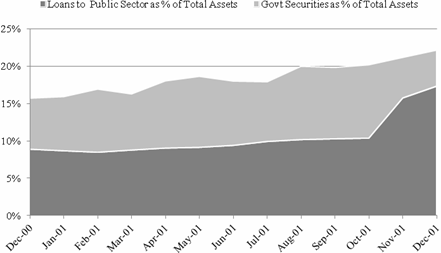
Source: Banco Central de la República Argentina (BCRA).

Source: Banco Central de la República Argentina (BCRA).
Figure 2. Greek banks' exposure to a default: Public debt as percentage of total assets
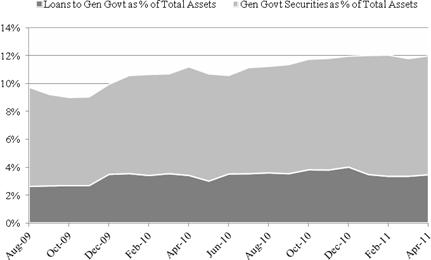
Source: Central Bank of Greece.

Source: Central Bank of Greece.
Figure 3. Argentina's deposits of the private sector: The dollar difference (and the "good contagion" to Uruguay)
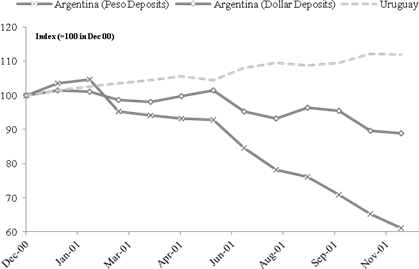
Source: Banco Central de la República Argentina (BCRA) and Banco Central del Uruguay (BCU).

Source: Banco Central de la República Argentina (BCRA) and Banco Central del Uruguay (BCU).
A detailed description of the anatomy of triplet (debt, currency, and bank) crises in Argentina and Uruguay (Levy Yeyati et al. 2010) reveals four distinct stylised facts that could shed some light on current and future developments in Greece:
- Macroeconomic risk matters more than bank fundamentals
Macroeconomic factors that are largely irrelevant in explaining depositor behaviour during tranquil times can rapidly become the main driver of market response during crisis episodes, even after controlling for standard bank-specific aspects such as asset quality or portfolio diversification. In a context of growing systemic risk, contagion across banks is inevitable.
As a result, once the run is underway, selective central bank assistance and restrictions on cash withdrawals are ineffective.
- Hard currency deposits are only a temporary remedy for currency risk
Dollar (or euro) deposits can contain depreciation expectations for a while, but ultimately the realisation that banks face exchange rate-related credit risk (from mismatched -- private and public -- dollar debtors with impaired capacity to pay) should flag the difference between dollars in the bank and dollars in the pocket, triggering a run on dollar deposits as well.1
- Liquidity flows across borders
A crisis in one country can contaminate banks in the neighbourhood in a matter of months. For example, the "good contagion" from the flight of wary Argentine depositors to the presumably safer Uruguayan banks (Figure 3) quickly turned into "bad contagion" once the "corralito" (the suspension of deposit convertibility) in Argentina forced them to start drawing down their offshore deposits (Figure 4).
A similar pattern already apparent in the Greek-Cyprus pair (Figure 5) can be easily undone if the run deepens and a deposit freeze in Greece cannot be avoided.
- Depositors run faster than bondholders
Trivially, deposits are on average much shorter than the average bond. As a result, while the run may be rooted in a debt sustainability problem, it is the bank run that often accelerates the proceedings. It was the "corralito" that brought people to the streets in Argentina in November 2001 (and brought the government down shortly thereafter). And the bank run preceded -- and to some extent triggered -- the currency and debt crisis in Uruguay 2002 (see De la Torre et al. [2003] for a detailed account of the Argentine crisis and its aftermath).
Figure 4. Deposits in Argentina and Uruguay: Good and bad contagion
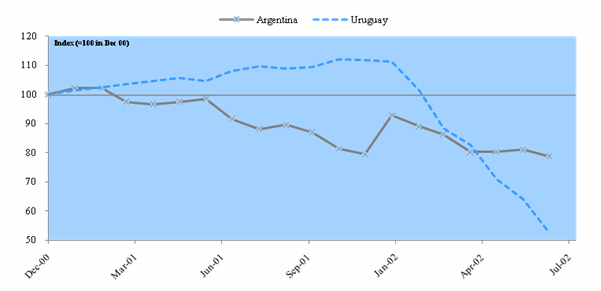
Note: The increase observed in Argentina's deposits in Jan 2002 is due to the forced conversion of dollar deposits at an exchange rate of 1.40 pesos. Sources: Banco Central de la República Argentina (BCRA) and Banco Central de Uruguay (BCU).

Note: The increase observed in Argentina's deposits in Jan 2002 is due to the forced conversion of dollar deposits at an exchange rate of 1.40 pesos. Sources: Banco Central de la República Argentina (BCRA) and Banco Central de Uruguay (BCU).
Figure 5. Deposits in Greece and Cyprus: Good contagion, for now
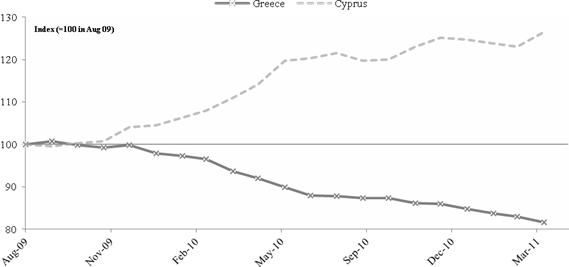
Source: Central Bank of Greece and Central Bank of Cyprus.

Source: Central Bank of Greece and Central Bank of Cyprus.
What It Means for Greece
These findings resonate strongly with the current debate on the European debt crisis. Current discussions about how to deal with the currency-growth-debt trap that engulfed Greece and threatens other nations cannot ignore how alternative exit strategies affect the banking system. Avoidance of a bank run would significantly reduce the magnitude of an already large problem.
But time is perhaps the relevant dimension in this case. To be sure, a bank run is not the only possible outcome at the current juncture. While it would be almost inevitable in the event of a debt restructuring or a euro exit (Blejer and Levy Yeyati 2011), it could be easily avoided if the final decision were to favour a regional bailout by Eurozone states -- e.g. a move towards a fiscal union that many see as a precondition for the long-run success of the euro experiment.
A protracted deliberation on these matters, however, may stress Greek banks, as depositors flee in anticipation. Thus, a generalised bank run and the inescapable freeze on bank deposits -- and, in turn, the derailment of current adjustment plans due to the resulting deepening of the recession and the civil unrest -- may end up being the unintended result of procrastination.
Market Discipline Redux
From a longer perspective that goes beyond short-term crisis management, the empirical evidence from Argentina and Uruguay (and, as we write this piece, possibly from Greece) suggests that the quest for market discipline embedded in the Basel principles faces serious shortcomings when market reactions are driven by macroeconomic conditions largely beyond the control of bank managers. This raises questions about the perception of market sensitivity as a disciplining device, and highlights the risk of focusing on micro factors at the expense of macro factors.
Current research on depositor behaviour emphasises the conventional view that they respond to bank-specific characteristics -- a principle known in the banking literature as "market discipline" and enshrined (and promoted) by Basel II as a critical source of financial stability. While many observers have flagged the possibility that generalised deposit runs can result from random events or contagion from weak banks to strong banks (hence, unrelated to the individual bank behaviour relevant for market discipline), the incidence of macroeconomic (in particular, credit and currency) risk has been largely ignored until very recently.2
Curiously, the historical emphasis placed by Basel on limiting the exposure to idiosyncratic risk (the target of both prudential regulation and market discipline) at the expense of the systemic (macroeconomic) risk behind most recent financial crises, contrasts with actual prudential banking practices in the emerging world, where a stream of financial crises in the 1990s taught regulators about the macro prudential threats the hard way.
This is certainly the reason why banks in emerging economies have displayed such a remarkably solid performance over the last three years -- and offer a useful mirror for battered banking sectors in industrialised countries looking for answers.
1 This sequence was also present in the brief post-Tequila Argentine crisis in 1995.
2 Bank-specific exposure to macroeconomic factors may not be factored into banks' funding costs in the pre-crisis period, despite the fact that deposit withdrawals during the crises are positively correlated with banks' exposure to currency and sovereign risk. However, it is easy to see how idiosyncratic credit risk can explode in the face of rising unemployment, contracting demand, and liquidity shortages, or how macroeconomic risk renders banks' internal rating-based models ineffective as it tends to substantially increase asset correlation. These, among other factors, explain why the informational content of bank-specific aspects (as captured by a simple regression of deposit demand against bank fundamentals) deteriorates markedly relative to macroeconomic factors as aggregate risk mounts. Risk-aware depositors are well advised to respond to macroeconomic indicators at the expense of backward-looking prudential indicators in a context of financial distress.
References
Manasse, Paolo (2011), "Greece, the Unbearable Heaviness of Debt", VoxEU.org, 24 May.
Mario I Blejer, and Eduardo Levy Yeyati (2010), "Leaving the Euro: What's in the Box?", VoxEU.org, 21 July.
Augusto de la Torre, Eduardo Levy Yeyati, and Sergio Schmukler (2003), "Living and Dying with Hard Pegs: The Rise and Fall of Argentina's Currency Board", Economía, 3(2):43-99.
Eduardo Levy Yeyati, María Soledad Martínez Pería, and Sergio Schmukler (2010), "Depositor Behaviour under Macroeconomic Risk: Evidence from Bank Runs in Emerging Economies", Journal of Money, Credit, and Banking, 42(4):585-614.



















Sem comentários:
Enviar um comentário